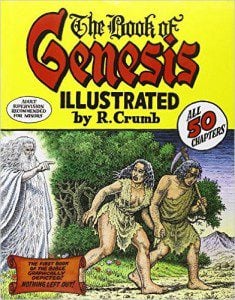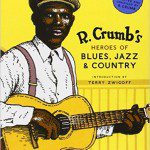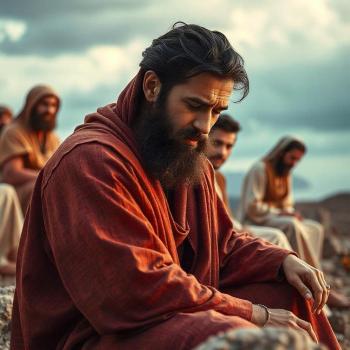
Three or four years back I queried Books and Culture about writing a review of Crumb’s, Book of Genesis Illustrated. I received a “thanks, but no thanks” letter. From the wording I couldn’t help but think Crumb was too hot for them to handle.
(Maybe that’s unfair, maybe I was the problem, I’m not the typical Books and Culture writer. That would have been fine with me, so long as they had handed the job on to someone they felt better about. But as far as I can tell, they never tried that.)
Ironically, Crumb was the very reason that National Public Radio and The Guardian (among others) did cover the book. It’s a shame. The Bible is our book. And if there ever was an opportunity to talk about Robert Crumb and what he represents, isn’t it when he takes it upon himself to illustrate the Bible?
(By the way, follow that Guardian link to samples of the art from Genesis Illustrated.)
Crumb predicted Christians would avoid touching his book. But he created the book anyway, and that’s worth thinking about. (I have read some superficial treatments of Genesis Illustrated by “progressive Christians” but they all had the sound of, “Hey, I’m cool too!” about them and fail to critically discuss the book.)
How to interpret a comic book
The misleading thing about comic books is the word “book”. If you try to interpret a comic book by the same standards as you would judge other books, well, you won’t know what to look for.
Comics have more in common with film than with books. It is a visual medium. The drawings tell the story. Text is usually kept to a minimum and is generally employed to support the art. That’s why comic book artists tend to overshadow their writers. (Stan Lee and Neil Gaiman ore obvious exceptions, still, where would Stan “the Man” Lee be without Jack “the King” Kirby?) And the connection to film goes even deeper, films often start off as comics. I’m not talking about the adaptions of superhero comics. I mean storyboarding. It isn’t uncommon for a director to have an artist layout an entire film in a series of sketches before filming begins. And in the cases of science fiction and fantasy, comic book artists are often brought into to create the concept art that sets and costumes are based on. (Moebius’s work in this regard for films like Alien and The Fifth Element is legendary.)
So the key to understanding a comic is framing, layout, and the aesthetic–what could be called, the “mood” it evokes. You need to think about angles, close ups, sequence of action, lighting, and so forth. These things help create emphasis–directing the eye as the story is told.
Let’s look at layout: how a page is laid out says something about what’s important. The size of the frames in relation to each other tells you what the story teller is stressing. And another thing–the reveal. Because it is still a book, the turn of the page is part of the layout. What you see first when you turn a page is often a revelation.
So how does Crumb do? His treatment is mixed. His aesthetic is good for the subject, and he does some things really well when it comes to layout. At the same time he overemphasizes some things, while missing the importance of other things.
Today I’ll treat what he does well. I’ll save the flaws for next time, with one exception that I can’t help but address today.

What Crumb did well (not intended to be an exhaustive list):
The Aesthetic
Genesis is gritty material, and it is difficult to think of a better person to illustrate it than Robert Crumb. Perhaps Barry Windsor Smith could have done it (but he appears to be in retirement), or Geof Darrow. Frankly, it was his reputation for dark themes that gave me hope that Crumb could convey something to modern people that they need to hear. What? That the bloody, distressing, and despairing history of the human race belies the powerful hand of a numinous Providence. It is Lovecraft’s Cosmicism in reverse. How did he do? That I’m leaving it for next time is a hint.
The Genealogies
I’m not kidding you. Because he was committed to giving us the text as it is, Crumb gave the genealogies more attention than I’ve ever seen them given anywhere else. Each “begat” is depicted meticulously. Crumb invested a great deal of time in them, and they are worth lingering over.
I don’t believe he actually went into the Hebrew for any clues as to how to portray each person. What comes through is their individuality, and how fashions and customs must have changed over time.
And by giving each image the same sized frame he subtly communicates the relentless power of time to destroy and recreate, like waves of the sea.
Underdogs
I suspected that Crumb would have something to show us when it came to the victims in Genesis. Crumb knows the underside of life and can sympathetically portray what it feels like to be exploited or betrayed. Eve, Abel, Sarai, Leah, Joseph, we can feel for them and identify with them. (Eve? Yes, I’ll get to her in a minute.)
Joseph’s treatment by his brothers is interesting. Rather than triumph in his vindication, there are subtle clues that Crumb doesn’t like Joseph. Amid the tears of joy, his toying with his brothers is not appreciated (we see it in the eyes of the onlooking slaves), and then the whole plenty and famine sequence makes Joseph look like an opportunist and a suck up. (In his end notes Crumb makes his thoughts clear on this.)
Women
This brings me to women. Women are always a problem for Crumb, he hates them (he hates everyone), but he admires them too. They’re the only adults he can find something to like about. (Thankfully Crumb ignores children. If his sexual tastes had moved in their direction he’d be in prison now.)
Unfortunately Crumb has fallen into the fever swamp of original matriarchy. This is somewhat like believing in Atlantis. Every rumor is clung to like a life preserver. Or it’s like Margret Meade in Samoa, making stuff up to support a Rousseauian fantasy. What is presented as evidence is like building a dinosaur from a tooth. But even this is made to further the cause: the fact that we have so little evidence is itself evidence to true believers that a conniving and overweening patriarchy was at work. Those priests and their schemes! That we have sympathetic treatment of women in parts of Genesis is evidence nonetheless that there must have been a matriarchy, since men are so incorrigibly evil when it comes to women. The only way something positive could be recorded about a woman is men were afraid of those powerful matriarchs. So which is it?
How about none of the above? Maybe this stuff just happened as the story records? Or perhaps patriarchy was necessary for survival and women actually depended upon the strength of men? (It was a violent world as Crumb helps us to remember.) Or just maybe men and women actually got along sometimes and even liked each other. I know, those things sound wildly improbable to the modern ear.
In Genesis though, Crumb does subtly give us a case for the women. It comes across in the sidelong look (Eve as she glances toward Adam when he blames her for his disobedience), the betrayal of Sarai when Abraham asks her to collude in lying about their marriage, the leering Pharaoh as he lusts for her. This is what I hoped to get from Crumb.
A highpoint is the story of Hagar. I was left puzzled by his endnotes though. He seems to contradict himself by taking Sarah’s side in this. He condemns Hagar of insubordination of all things. Apparently it is just fine to submit to the abuses of a matriarch for Crumb.
Well, as you can see I’m already slipping into the negative side of my critique. And while I’ve hinted at Crumb’s conservatism, I still haven’t explained myself.
Those things will have to wait. I thought this would be a three part review, but it may grow into four.















